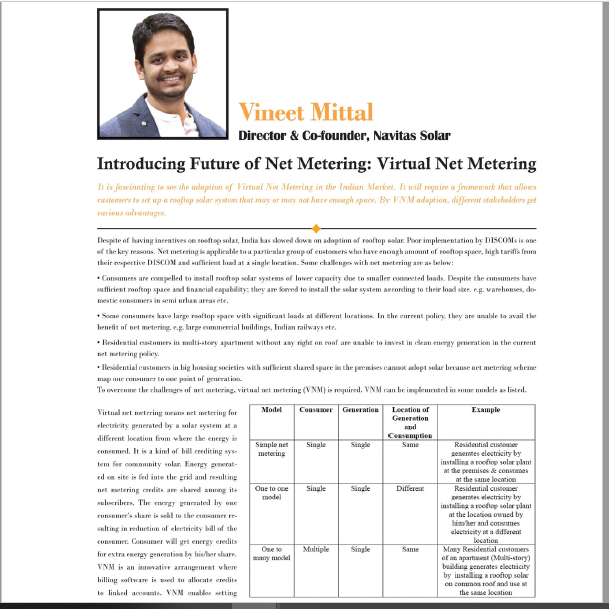Vineet Mittal on Virtual Net Metering (VNM)
Despite of having incentives on rooftop solar, India has slowed down on adoption of rooftop solar. Poor implementation by DISCOMs is one of the key reasons. Net metering is applicable to a particular group of customers who have enough amount of rooftop space, high tariffs from their respective DISCOM and sufficient load at a single location. Some challenges with net metering are as below:
- Consumers are compelled to install rooftop solar systems of lower capacity due to smaller connected loads.
Despite the consumers have sufficient rooftop space and financial capability; they are forced to install the solar system according to their load size.
e.g. warehouses, domestic consumers in semi urban areas etc. Residential customers in multi-story apartment without any right on roof are unable to invest in clean energy generation in the current net metering policy. - Some consumers have large rooftop space with significant loads at different locations. In the current policy, they are unable to avail the benefit of net metering. e.g. large commercial buildings, Indian railways etc.
- Residential customers in big housing societies with sufficient shared space in the premises cannot adopt solar because net metering scheme map one consumer to one point of generation.
To overcome the challenges of net metering, virtual net metering is required. VNM can be implemented in some models as listed.
| Model | Consumer | Generation | Location of Generation and Consumption | Example |
|---|---|---|---|---|
| Simple net metering | Single | Single | Same | Residential customer generates electricity by installing a rooftop solar plant at the premises & consumes at the same location |
| One to one model | Single | Single | Different | Residential customer generates electricity by installing a rooftop solar plant at the location owned by him/her and consumes electricity at a different location |
| One to many model | Multiple | Single | Same | Many Residential customers of an apartment (Multi-story) building generates electricity by installing a rooftop solar on common roof and use at the same location |
| Multiple | Single | Different | Many Residential customers of an apartment (Multi-story) building generates electricity by installing a solar plant at different location and use at the different location | |
| Multiple | Multiple | Same | Many Residential customers of a housing society generates electricity by installing multiple rooftop solar plants on society premises and use at the same location | |
| Multiple | Multiple | Different | Many Residential customers of a housing society generates electricity by installing multiple rooftop solar plants on society premises and use at different locations |
Virtual net metering means net metering for electricity generated by a solar system at a different location from where the energy is consumed. It is a kind of bill crediting system for community solar. Energy generated on site is fed into the grid and resulting net metering credits are shared among its subscribers. The energy generated by one consumer’s share is sold to the consumer resulting in reduction of electricity bill of the consumer. Consumer will get energy credits for extra energy generation by his/her share.
VNM is an innovative arrangement where billing software is used to allocate credits to linked accounts. VNM enables setting up of on/off site solar power plants under joint ownership. A billing software is used for netting; single generation can be mapped to multiple consumers, which allows sharing the benefits of net metering among participating consumers on predetermined basis.
VNM allows a single customer to install a single power plant with higher capacity equivalent to aggregated loads from multiple premises and customers. By adopting VNM, rooftop solar adoption can be increased. VNM enables customers to choose locations of energy generation and consumption. It helps to reduce energy bill as well as gives environmental benefits of using renewable energy.
A new mechanism should be formed to implement VNM like a category of consumers as Net Generator can be created which generates electricity and export the energy to the grid and others are Net consumers who use energy through utility grid. When VNM is adapted, utility is compensated for the use of infrastructure that minimizes cost-shifting problem.
It is fascinating to see adaption of Virtual Net Metering in Indian Market. It will require a framework that allows customers to set up a rooftop solar system who may or may not have enough space. By VNM adoption, different stakeholders get various advantages.
For the Policymaker, deployment of rooftop solar can be easy and it will become easy to widen and achieve the RE targets. For regulators, cross subsidy charges will be reduced among the consumer categories, so they will be able to design a dynamic tariff design structure based on avoided charges. From a utility perspective, with the use of rooftop solar, peak load reduction will be possible which will be a great help for the grid. Also, for overloaded and loss making distribution zones, this can turn out as a great solution. According to a developer, they will get to develop large solar power plants with improved economics. For an end consumer, it will open the doors to invest in green energy and reduce electricity bills by using the same.
VNM is already implemented in many states of USA like California, Colorado, Connecticut, Delaware, Hawaii, Maine, Maryland, Massachusetts, Minnesota, New Hampshire, New York, Oregon, Vermont, and Washington D.C. Getting inspired by USA’s success by enabling VNM, many countries like Brazil, Australia, Greece, Canada have also followed the same path.
In India, there may be some challenges with the implementation of VNM. Virtual Net metering can be utilized to provide a platform which can attract wide range of customers with insufficient rooftop space. This can turn out as a boon for urban customers who are driven by economic and environmental factors to adopt solar. VNM gives a sustainable solution for residential consumers in multi-tenant buildings and group housing societies to adopt solar energy.




 Online | Privacy policy
Online | Privacy policy
Related Posts
You May Also Like
Bonito Series: Driving Innovation in…
Read MoreTOPCon Series: The Next Generation…
Read MoreValuable Points to Remember During…
Read MoreNavitas Planet Partners with Hysolwin…
Read MoreDriving Towards a Sustainable Future:…
Read MoreWhy Do Top-Grade EVA Sheets…
Read MoreBonito Series: Driving Innovation in…
Read MoreTOPCon Series: The Next Generation…
Read MoreValuable Points to Remember During…
Read MoreNavitas Planet Partners with Hysolwin…
Read MoreDriving Towards a Sustainable Future:…
Read MoreWhy Do Top-Grade EVA Sheets…
Read MoreBonito Series: Driving Innovation in…
Read MoreTOPCon Series: The Next Generation…
Read MoreValuable Points to Remember During…
Read MoreNavitas Planet Partners with Hysolwin…
Read More